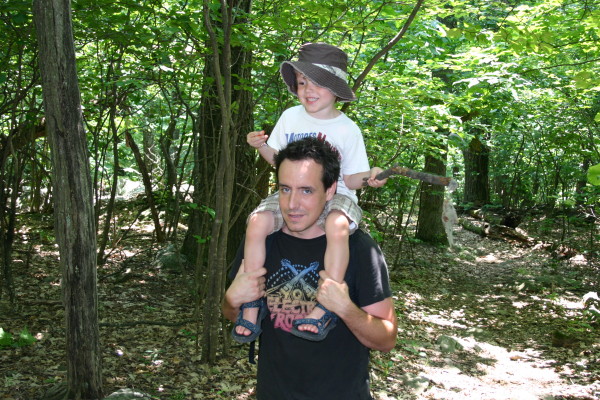I wanted to expand on my previous entry about getting your kids outdoors. My family loves to hike! Hiking is great exercise, an excellent way to enjoy nature, a learning opportunity for kids, and an amazing way to get in some family time.
But it isn’t always easy going on a long (or even a short) hike with a small child. Our son inevitably ends up riding on my husband’s shoulders since he has outgrown backpack carriers.

As a result of our love for hiking, I have learned a few tricks and tips for hiking with children.
Hiking Essentials:
- Use a carrier when your child is 2 and under. We used a front carrier when our son was an infant and then a backpack carrier after he outgrew the front carrier.
- For walking kids under the age of 3, limit your hike to one mile. Be prepared to take a lot of breaks or to do a lot of carrying.
- For kids between the ages of 3 and 5, limit your hike to two miles (unless you are willing to hoist them on your shoulders as my patient husband does).
- Kids ages 6 and up can probably hike as far as 6 miles but it really depends on the difficulty of the hike and the stamina of your child.
- Bring plenty of water and lots of snacks (try granola bars, trail mix, nuts, dried fruit and crackers). But please don’t leave behind any trash!
- Wear sturdy shoes.
- Dress in comfortable layers so you can add or remove clothing as necessary. If you want to avoid bugs and poison ivy, wear long sleeves and pants. Hats and sunglasses can be useful too.
- Be prepared to go slow and make a lot of stops. Kids are curious – encourage their natural inclination to explore nature and let them stop to look at bugs and moss. And remember that they can’t walk as fast as you so slow down to their pace.
- Know where you are going. It’s no fun to get lost, especially with kids. Use trail maps and mark your starting location on your GPS device (try the ParkIt app on the iPhone so you can pinpoint your starting location).
Making Hiking Fun:
- Try geocaching. I can’t say enough good things about this techie treasure hunt. If you have an iPhone or any other GPS device, you can use it to find everything from trackable coins to toys while you are on your hikes. My son will hike for hours if he knows he will be able to find a hidden treasure. There are over a million geocaches around the world so chances are there will be at least one near you.
- Put your kid in charge of the map, and let her lead the way (with your guidance of course). Most parks have trail maps available. If not, there are some great trail map apps out there such as the American Hiking Society’s Hike app for the iPhone.
- Play an alphabet game. Have your child identify things along your hike that start with the different letters (e.g. A is for acorn, B is for butterfly).
- Do a scavenger hunt. Give your child a list of things to hunt for such as seeds, flowers and pinecones (draw pictures if your child can’t read yet). Take photos of your finds and “Leave No Trace.”
- Bring field guides. Help your child identify interesting plants, animals, bugs and trees. Bring a journal to take note of your finds or take pictures with a child-friendly camera. You can also find field guide apps from the National Audubon Society for the iPhone.
- Choose hikes with plenty of visual interest. A hike along a stream or through a meadow is more likely to keep your child interested.
- Play a game of “I Spy.”
- Hike at night. Bring flashlights and choose a familiar trail.
- Look for animal footprints and try to identify them.
- Take a break and wade through a creek or swim in a swimming hole.
- Build a stone sculpture. Collect small rocks along your hike and then look for the perfect spot to build a stone creation. My son loves to leave these works of art on our hikes and gets excited by the idea that other people will find them.
- Check out www.naturerocks.org for more fun outdoor activities.
Want more One Part Sunshine? Here’s how:
- Follow us on Twitter
- Like us on Facebook
- Check us out on Pinterest
- Subscribe to our email newsletter
NOTICE: Blog posts on OnePartSunshine.com may contain affiliate links. In other words, if you buy something after clicking on a link in this post, then the author might receive an affiliate commission.
